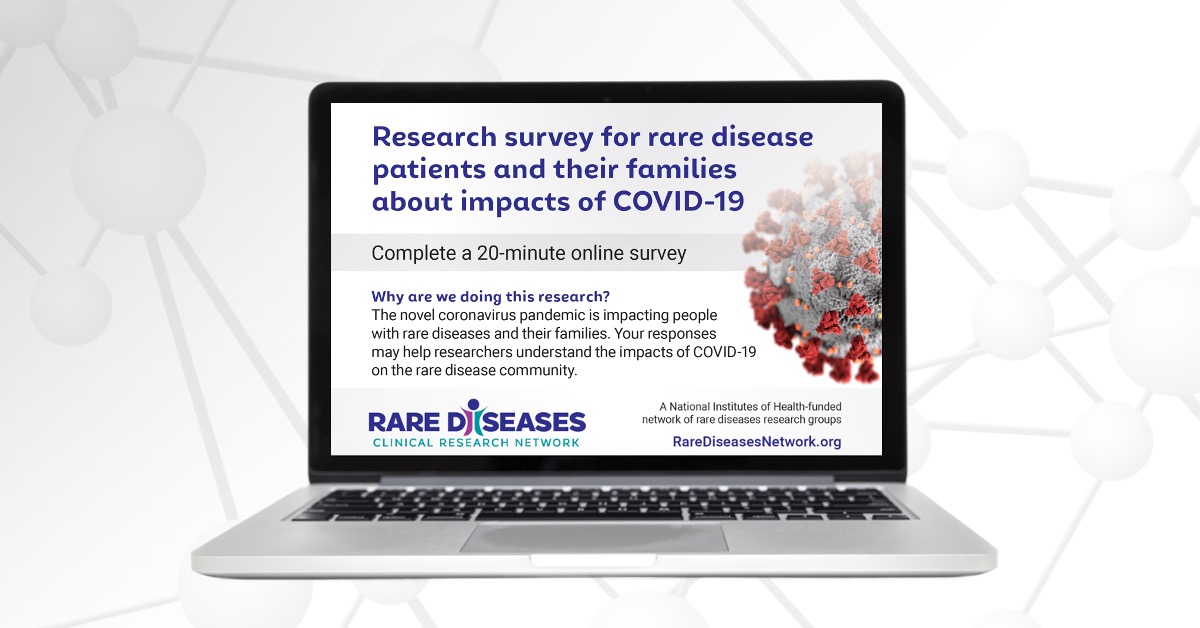The devastating impact of COVID-19 on the general population is well-documented—but less is known about the millions of people living with rare diseases. How has the pandemic affected this already vulnerable population?
In May 2020, the National Institutes of Health-funded Rare Diseases Clinical Research Network (RDCRN) launched an online survey to find out how the COVID-19 pandemic impacted individuals with rare diseases, their families, and their caregivers.
Now, researchers are sharing what they’ve learned, publishing the results on February 14, 2024, in the Journal of Medical Internet Research (JMIR) Public Health and Surveillance (PHS). Their insights—including access to care, medication use, and mental and physical well-being—are helping us understand the unique challenges faced by this population and how we can better support them.
Developing the Survey
An estimated 30 million people in the United States live with a rare disease, which is defined as a condition affecting fewer than 200,000 Americans. Rare diseases are often difficult to diagnose and lack specific treatments. Some people with rare diseases live with respiratory issues, compromised immunity, and other comorbidities that are risk factors for COVID-19. However, few studies have focused on this population’s experiences during the pandemic.
As a worldwide rare diseases research network, the RDCRN has a unique ability to explore this topic in-depth. The network is made up of 20 research groups working together with about 140 patient advocacy groups to study more than 200 rare diseases.
When the COVID-19 pandemic began in 2020, conversations between RDCRN researchers and patient advocates turned to the challenges faced by rare disease patients and families. Many were expressing concern about the effects of COVID-19, access to medication, and maintaining medical care.
Quickly, the need to understand this impact became clear to network members. Scientists, clinicians, advocates, and patients collaborated to develop a cross-sectional survey to describe the characteristics of COVID-19 infection in the rare disease population.
A diverse team of experts ensured the survey focused on learning about the full spectrum of rare disease patients—were certain subgroups affected more frequently or severely than others? Did the pandemic change disease symptoms and treatment patterns? What were the specific concerns of people with different rare diseases, family members, or caregivers?
The network’s Data Management and Coordinating Center (DMCC) at Cincinnati Children’s Hospital Medical Center created the online survey, which was widely shared throughout the rare disease community. Participants answered questions about COVID-19 symptoms, self-reported COVID-19 infection, rare disease symptoms, medications, access to care, and psychological well-being.
Quantifying the Impact
From May to December 2020, more than three thousand people responded to the survey. A wide range of rare diseases were represented, including myasthenia gravis, amyotrophic lateral sclerosis (ALS), eosinophilic gastrointestinal disorders, mitochondrial disease, cystic fibrosis, and primary ciliary dyskinesia.
Results show that self-reported COVID-19 cases were more than double the number expected based on the general population rates. People with rare diseases who had other health conditions were more likely to contract COVID-19. They also experienced an increase in the severity of rare disease-related symptoms.
“It was unexpected that among those who reported acquiring COVID-19, the illness was not severe,” says Maurizio Macaluso, MD, DPH, co-principal investigator for the DMCC. “Symptoms lasted on average less than 30 days, and hospitalization and mechanical ventilator support were relatively uncommon. Another surprising finding was that while those who acquired COVID-19 made greater use of selected medications, those who did not acquire COVID-19 reduced use and dosage of many medications during the pandemic. We did not expect uninfected respondents to report reduced medication use.”
Regardless of infection status, the pandemic made it more challenging for all people with rare diseases to access medical care, treatments, and hospitalization. Patients and their families also experienced negative impacts on mental health.
Next, researchers are conducting follow-up surveys of the respondents, as well as a control group from the general population. Results will help us learn more about the differences between people who live with rare diseases and healthier individuals, including adherence to public health recommendations and vaccinations.
“There is an obvious need for continued surveillance,” says Macaluso. “The pandemic has decreased in intensity but continues, with new variants of the virus appearing in waves. Long-term effects of the infection—'long COVID’—are showing us that the virus is changing, adapting, and spreading. We need to make sure that we have good data on how these changes affect people who live with rare diseases.”
Learn more about the RDCRN’s surveys on the impacts of COVID-19 on the rare disease community.
The Rare Diseases Clinical Research Network (RDCRN) is funded by the National Institutes of Health (NIH) and led by the National Center for Advancing Translational Sciences (NCATS) through its Division of Rare Diseases Research Innovation (DRDRI).


